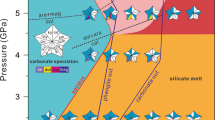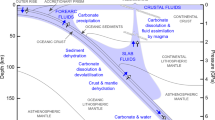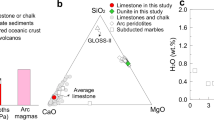Abstract
More than half a gigaton of CO2 is subducted into Earth’s interior each year1. At least 40% of this CO2 is returned to the atmosphere by arc volcanism2,3,4. Processes that are known to release carbon from subducting slabs—decarbonation or carbonate dissolution in fluids—can account for only a portion of the CO2 released at arc volcanoes5. Carbonatitic liquids may form from the subducting crust, but are thought to form only at very high temperatures. Melting of carbonated rocks could restrict the subduction of carbon into the deeper Earth. However, the behaviour of such rock types in subduction zones is unclear. Here I use laboratory experiments to show that calcium-rich hydrous carbonatitic liquids can form at temperatures as low as 870 to 900 °C, which corresponds to shallow depths of just 120 km beneath subduction zone arcs, in warm thermal regimes. I find that water strongly depresses the solidus for hydrous carbonate gabbro and limestone rocks, creating carbonatitic liquids that efficiently scavenge volatile elements, calcium and silicon, from the slab. These extremely mobile and reactive liquids are expected to percolate into the mantle wedge, and create a CO2 source for subduction zone magmatism. Carbonatitic liquids thus provide a potentially significant pathway for carbon recycling at shallow depths beneath arcs.
This is a preview of subscription content, access via your institution
Access options
Subscribe to this journal
Receive 12 print issues and online access
$259.00 per year
only $21.58 per issue
Buy this article
- Purchase on Springer Link
- Instant access to full article PDF
Prices may be subject to local taxes which are calculated during checkout



Similar content being viewed by others
References
Burton, M. R., Sawyer, G. M. & Granieri, D. Deep carbon emissions from volcanoes. Rev. Mineral. Geochem. 75, 323–354 (2013).
Hilton, D. R., Fischer, T. P. & Marty, B. Noble gases and volatile recycling at subduction zones. Rev. Mineral. Geochem. 47, 319–370 (2002).
Dasgupta, R. & Hirschmann, M. M. The deep carbon cycle and melting in Earth’s interior. Earth Planet. Sci. Lett. 298, 1–13 (2010).
Fischer, T. P. & Marty, B. Volatile abundances in the sub-arc mantle: Insights from volcanic and hydrothermal gas discharges. J. Volcanol. Geotherm. Res. 140, 205–216 (2005).
Schmidt, M. W. & Poli, S. Devolatilisation during subduction. Treatise Geochem. 4, 669–701 (2014).
Gorman, P. J., Kerrick, D. M. & Connolly, J. A. D. Modeling open system metamorphic decarbonation of subducting slabs. Geochem. Geophys. Geosyst. 7, Q04007 (2006).
Poli, S., Franzolin, E., Fumagalli, P. & Crottini, A. The transport of carbon and hydrogen in subducted oceanic crust: An experimental study to 5 GPa. Earth Planet. Sci. Lett. 278, 350–360 (2009).
Tumiati, S., Fumagalli, P., Tiraboschi, C. & Poli, S. An experimental study on COH-bearing peridotite up to 3.2 GPa and implications for crust-mantle recycling. J. Petrol. 54, 453–479 (2013).
Grassi, D. & Schmidt, M. W. The melting of carbonated pelites from 70 to 700 km depth. J. Petrol. 4, 765–789 (2011).
Yaxley, G. M. & Brey, G. P. Phase relations of carbonate-bearing eclogite assemblages from 2.5 to 5.5 GPa: Implications for petrogenesis of carbonatites. Contrib. Mineral. Petrol. 146, 606–619 (2004).
Manning, C. E., Shock, E. L. & Sverjensky, D. A. The chemistry of carbon in aqueous fluids at crustal and upper-mantle conditions: Experimental and theoretical constraints. Rev. Mineral. Geochem. 75, 109–148 (2013).
Ague, J. J. & Nicolescu, S. Carbon dioxide released from subduction zones by fluid-mediated reactions. Nature Geosci. 7, 355–360 (2014).
Dasgupta, R., Hirschmann, M. M. & Withers, A. C. Deep global cycling of carbon constrained by the solidus of anhydrous, carbonated eclogite under upper mantle conditions. Earth Planet. Sci. Lett. 227, 73–85 (2004).
Kiseeva, E. S. et al. An experimental study of carbonated eclogite at 3.5–5.5 GPa—implications for silicate and carbonate metasomatism in the cratonic mantle. J. Petrol. 53, 727–759 (2012).
Wyllie, P. J. & Boettcher, A. L. Liquidus phase relationships in the system CaO–CO2–H2O to 40 kilobars pressure with petrological applications. Am. J. Sci. 267-A, 489–508 (1969).
Irving, A. J. & Wyllie, P. J. Subsolidus and melting relationships for calcite, magnesite and the join CaCO3–MgCO3 to 36 kb. Geochim. Cosmochim. Acta 39, 35–53 (1975).
Perk, N. W., Coogan, L. A., Karson, J. A., Klein, E. M. & Hanna, H. D. Petrology and geochemistry of primitive lower oceanic crust from Pito Deep: Implications for the accretion of the lower crust at the Southern East Pacific Rise. Contrib. Mineral. Petrol. 154, 575–590 (2007).
Godard, M. et al. Geochemistry of a long in-situ section of intrusive slow-spread oceanic lithosphere: Results from IODP Site U1309 (Atlantis Massif, 30° N Mid-Atlantic-Ridge). Earth Planet. Sci. Lett. 279, 110–122 (2009).
Meyer, P. S., Dick, H. J. B. & Thompson, G. Cumulate gabbros from the Southwest Indian Ridge, 54° S–7°16′ E: Implications for magmatic processes at slow spreading ridge. Contrib. Mineral. Petrol. 103, 44–63 (1989).
Bach, W. et al. The geochemical consequences of late-stage low-grade alteration of lower ocean crust at the SW Indian Ridge: Results from ODP Hole 735B (Leg 176). Geochim. Cosmochim. Acta 65, 3267–3287 (2001).
Ranero, C. R., Phipps Morgan, J., McIntosh, K. & Reichert, C. Bending-related faulting and mantle serpentinization at the Middle America trench. Nature 425, 367–373 (2003).
Poli, S. & Schmidt, M. W. Experimental subsolidus studies on epidote minerals. Epidotes. Rev. Mineral. Geochem. 56, 171–195 (2004).
Hammouda, T. High-pressure melting of carbonated eclogite and experimental constraints on carbon recycling and storage in the mantle. Earth Planet. Sci. Lett. 214, 357–368 (2003).
Tsuno, K. & Dasgupta, R. The effect of carbonates on near-solidus melting of pelite at 3 GPa: Relative efficiency of H2O and CO2 subduction. Earth Planet. Sci. Lett. 319–320, 185–196 (2012).
Yaxley, G. & Green, D. H. Experimental demonstration of refractory carbonate-bearing eclogite and siliceous melt in the subduction regime. Earth Planet. Sci. Lett. 128, 313–325 (1994).
Syracuse, E. M., van Keken, P. E. & Abers, G. A. The global range of subduction zone thermal models. Phys. Earth Planet. Inter. 183, 73–90 (2010).
Wallace, M. E. & Green, D. H. An experimental determination of primary carbonatite magma composition. Nature 335, 343–345 (1988).
Plank, T. The chemical composition of subducting sediments. Treatise on Geochem. 4, 607–629 (2014).
Connolly, J. A. D. Multivariable phase diagrams: An algorithm based on generalized thermodynamics. Am. J. Sci. 290, 666–718 (1990).
Franzolin, E., Schmidt, M. W. & Poli, S. Ternary Ca–Fe–Mg carbonates: Subsolidus phase relations at 3.5 GPa and a thermodynamic solid solution model including order/disorder. Contrib. Mineral. Petrol. 161, 213–227 (2011).
Acknowledgements
I thank D. H. Green, M. W. Schmidt, N. Malaspina, P. Fumagalli, S. Tumiati, T. Hammouda and J. Hermann for fruitful discussions on the petrology of subduction zones. E. Erba introduced me to the world of pelagic sediments. A. Risplendente is acknowledged for assistance with the electron microprobe. Comments from T. John greatly improved the manuscript. Funding provided by the Italian program PRIN2012R33ECR.
Author information
Authors and Affiliations
Corresponding author
Ethics declarations
Competing interests
The author declares no competing financial interests.
Supplementary information
Supplementary Information
Supplementary Information (PDF 4684 kb)
Rights and permissions
About this article
Cite this article
Poli, S. Carbon mobilized at shallow depths in subduction zones by carbonatitic liquids. Nature Geosci 8, 633–636 (2015). https://doi.org/10.1038/ngeo2464
Received:
Accepted:
Published:
Issue Date:
DOI: https://doi.org/10.1038/ngeo2464
This article is cited by
-
Carbonate-rich crust subduction drives the deep carbon and chlorine cycles
Nature (2023)
-
Silica is unlikely to be soluble in upper crustal carbonatite melts
Nature Communications (2023)
-
Tetracarbonates in silicate melts may be at the origin of a deep carbon reservoir in the deep Earth
Communications Earth & Environment (2023)
-
Pervasive hydrous carbonatitic liquids mediate transfer of carbon from the slab to the subarc mantle
Communications Earth & Environment (2023)
-
Recycled carbonates elevate the electrical conductivity of deeply subducting eclogite in the Earth’s interior
Communications Earth & Environment (2023)



